Tay Phuong Pagoda, a precious gem of the Doai region, has long been a famous spiritual destination near Hanoi, attracting visitors from all directions with its ancient architecture and profound cultural and historical values. Not only a place for pilgrimage and New Year’s prayers for peace, Tay Phuong Pagoda is also a priceless art museum with unique sculptural masterpieces, especially the renowned Arhat statues, containing the essence of Vietnamese culture. Let’s explore Tay Phuong Pagoda with “Travel Around The World” to fully appreciate the spiritual beauty and unique architecture of this place.
Introducing Tay Phuong Pagoda: A Special National Relic
Tay Phuong Pagoda, also known as Sung Phuc Tu, is located on the peak of Cau Lau Mountain, in Thach Xa commune, Thach That district, Hanoi. With a prime location, leaning against the mountain and surrounded by poetic natural scenery, Tay Phuong Pagoda offers a peaceful space, dispelling the hustle and bustle of urban life.
The history of Tay Phuong Pagoda is closely linked to the process of Buddhism’s introduction and development in Vietnam. According to legend, in the 9th century, Cao Bien, the Jiedushi of the Tang Dynasty, came here to build a religious structure. However, historical records clearly state that Tay Phuong Pagoda was built and reached its present scale from the time of Mac Phuc Nguyen (1547 – 1561).
In 2015, Tay Phuong Pagoda was honored to be recognized by the Prime Minister as a Special National Relic. Among them, 34 ancient statues in the pagoda were recognized as National Treasures, affirming the unparalleled artistic and cultural value of this ancient pagoda.
Every year, in March of the lunar calendar, Tay Phuong Pagoda jubilantly organizes a traditional festival, lasting from the 6th to the 10th day of the 3rd lunar month. The festival attracts a large number of tourists and local people to participate in many unique cultural and religious activities such as palanquin processions, rituals, and folk games (tug-of-war, human chess, wrestling…) to pray for a new year of peace and happiness. Traveling to Tay Phuong Pagoda during the festival is a great opportunity to immerse yourself in the sacred atmosphere and experience the traditional cultural beauty of the Doai region.
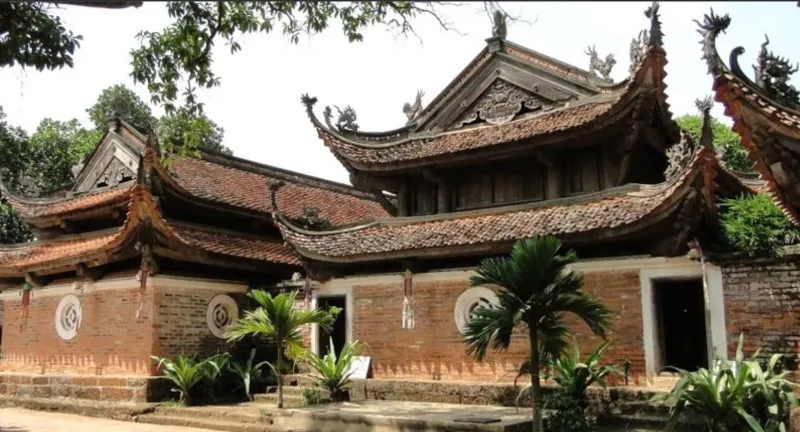
Detailed Guide for Tay Phuong Pagoda Travel Itinerary
To make your trip to Tay Phuong Pagoda complete and meaningful, “Travel Around The World” would like to suggest a detailed itinerary, helping you easily explore this ancient pagoda.
Transportation to Tay Phuong Pagoda
There are two main means of transportation to Tay Phuong Pagoda from the center of Hanoi:
- Private vehicles (car, motorbike): Starting from the center of Hanoi, follow Tran Duy Hung street, then turn onto Thang Long Avenue. Continue to the overpass at the intersection of Thang Long Avenue – Thach That, Quoc Oai, turn left into Quoc Oai. Go further about 5km, turn right and at Thach Xa intersection, you will see signs to Tay Phuong Pagoda. Turn left following the signs and go another 4-5km to reach the pagoda gate. The route is quite easy and there are many signs.
- Public transport (bus): You can choose bus route number 89 (Yen Nghia – Son Tay). This bus departs from Yen Nghia bus station, passes through Thach That and stops at Son Tay bus station. Get off the bus at the stop near Tay Phuong Pagoda and walk a short distance or take a motorbike taxi to reach the pagoda.
Entrance Fee and Opening Hours of Tay Phuong Pagoda
- Entrance fee: 10,000 VND/person (applies to both domestic and international visitors). Free entrance on Vietnam Cultural Heritage Day (November 23) and major holidays such as the 30th, 1st, 2nd, and 3rd days of the Lunar New Year.
- Parking fee: Parking fees vary depending on the type of vehicle.
- Opening hours: The pagoda is open to visitors daily, from early morning to late afternoon. However, to ensure a peaceful and solemn space, you should visit the pagoda during office hours.
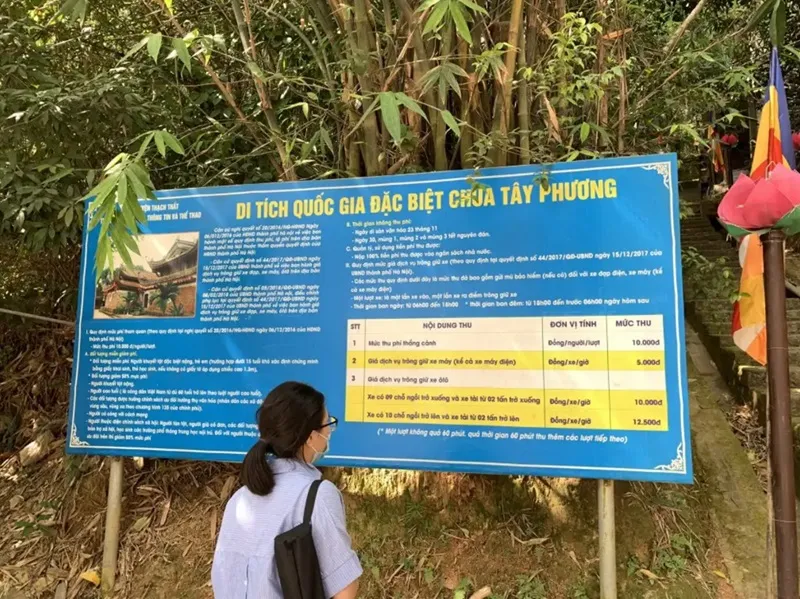
Exploring the Detailed Tay Phuong Pagoda Tour Route
Tay Phuong Pagoda is a unique architectural complex, built on a mountainside with many different structures. The pagoda tour route usually starts from the foot of the mountain and follows the stone steps to the top, exploring each unique architectural work.
Lower Gate (Tam Quan Ha) and Upper Gate (Tam Quan Thuong): Majestic Welcoming Gates
The journey to Tay Phuong Pagoda begins at Tam Quan Ha, the first pagoda gate located at the foot of Cau Lau Mountain. Tam Quan Ha consists of three doors, the central door being the widest and highest, symbolizing the majesty and solemnity of the sacred place.
Continuing the journey, you will climb 237 ancient laterite stone steps to reach Tam Quan Thuong. Laterite stone is a typical building material of the Doai region, bringing a rustic and ancient beauty to the structure. Tam Quan Thuong also has a three-door architecture similar to Tam Quan Ha.
On both sides of the pillars of Tam Quan Thuong are carved meaningful parallel sentences: “Seven golden lotuses lift jade feet / Three thousand worlds welcome the Tathagata.” The couplet evokes the event of the birth of Shakyamuni Buddha, taking seven steps and each step blooming a golden lotus, expressing respect and admiration for the Buddha.
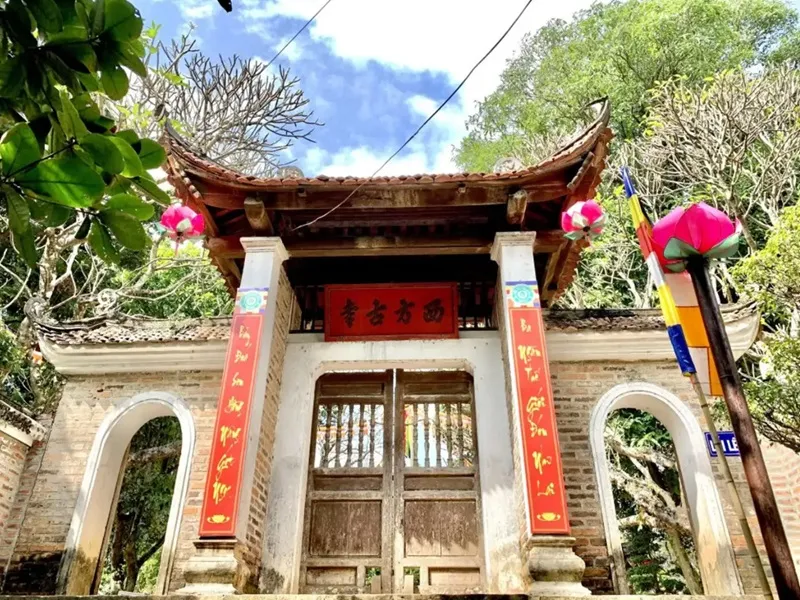
Son Than Shrine: A Unique Feature in Vietnamese Pagoda Architecture
Turning left from the main pagoda, you will reach Son Than Shrine, a small architectural work but of significant importance in Vietnamese folk beliefs. Son Than Shrine is both a place to worship the mountain god, the god who governs Cau Lau Mountain, and a place to worship Duc Ong, the Dharma protector of Buddhism. The shrine’s architecture is simple, bearing traditional features with bright red tiled roofs and exquisitely carved wooden details.
Lower Temple (Chua Ha), Middle Temple (Chua Trung), Upper Temple (Chua Thuong): Unique “Tam” (Three) Shaped Architecture
The architectural highlight of Tay Phuong Pagoda is the three main temples: Chua Ha, Chua Trung, and Chua Thuong, arranged in parallel in a “Tam” (三 – three) shape on the same high foundation. Each temple has a two-story, eight-roof overlapping roof architecture, a unique roof style of Vietnam. The pagoda walls are built with Bat Trang bricks exposed, creating a rustic, simple beauty and showing off the characteristic red color of the bricks. The round windows whitewashed on the pagoda walls symbolize the Buddhist philosophy of “form is emptiness, emptiness is form”.
- Chua Ha (Lower Temple): Where the statue of Avalokiteśvara Bodhisattva with a Thousand Arms and Eyes is worshiped, a symbol of the immeasurable compassion and wisdom of Buddhism. On both sides of the Bodhisattva statue are statues of Ngoc Nu and Dong Tu fairies, representing purity and elegance.
- Chua Trung (Middle Temple): Unlike many other pagodas, Chua Trung at Tay Phuong Pagoda has a taller and narrower architecture than Chua Ha and Chua Thuong. This place worships the Tuyet Son statue, depicting the image of Shakyamuni Buddha during his ascetic practice before enlightenment. The Tuyet Son statue evokes deep emotions about the perseverance and will to overcome difficulties of the Buddha.
- Chua Thuong (Upper Temple): The highest pagoda and located in the center of the complex. Chua Thuong worships the Three Buddhas, representing the Buddhas of the three times: past, present, and future. The most special feature in Chua Thuong is the famous Eighteen Arhats statue set, considered a priceless treasure of Tay Phuong Pagoda and of Vietnamese sculpture.
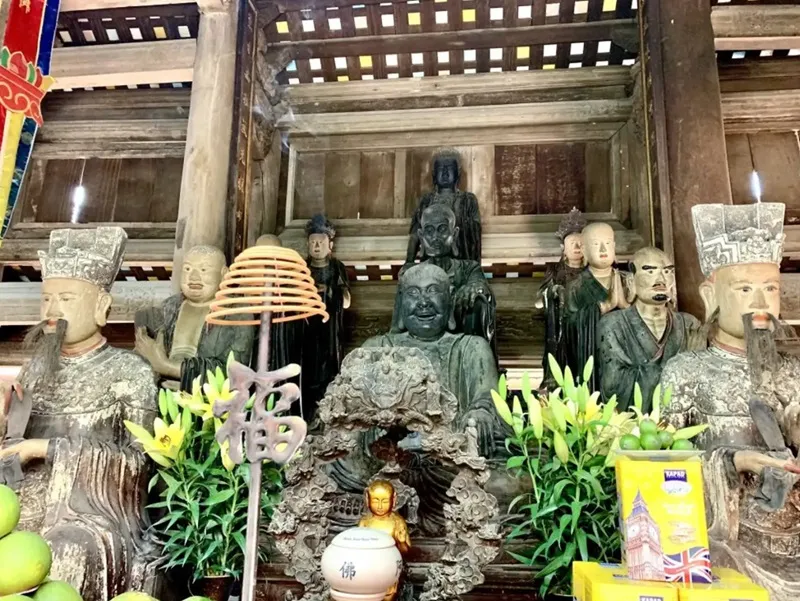
Eighteen Arhats Statues: Priceless Sculptural Masterpieces
The Eighteen Arhats statues of Tay Phuong Pagoda are one of the most attractive points for tourists when visiting Tay Phuong Pagoda. The 18 Arhat statues are carved from jackfruit wood, lacquered and gilded, each statue with a unique face, posture, and expression, vividly portraying different human emotions. The details on the statues, from the folds of robes, skin texture, to eyes and smiles, are meticulously and exquisitely carved, showing the pinnacle of sculpting skills of ancient artisans.
The Arhat statues of Tay Phuong Pagoda are not only of artistic value but also of profound cultural and spiritual value. Arhat statues represent different stages on the path of human cultivation and enlightenment, while conveying lessons about morality and profound human perspectives.
Ancestral House (Nha To), Mother Goddess House (Nha Mau), Guest House (Nha Khach): Spiritual Living Spaces
Behind the main pagoda is the area of Nha To and Nha Mau, built in the “Nhi” (二 – two) shape. Nha To is the place to worship the Patriarchs who contributed to building and developing the pagoda, while Nha Mau is the place to worship Mother Lieu Hanh, an important Holy Mother in Vietnamese folk beliefs.
Nha Khach is located on the right flank of the main pagoda, recently restored but still retaining traditional architecture, harmonizing with the overall architecture of Tay Phuong Pagoda. Nha Khach is a place to welcome visitors from all directions to visit and worship Buddha at the pagoda.
Combining Tay Phuong Pagoda Travel and Resort in Thach That
After visiting Tay Phuong Pagoda, you can combine travel with relaxation at the beautiful resorts and homestays in Thach That to enjoy the fresh natural space and relax after stressful working days. Hoang Long Resort, a 4-star eco-resort near Tay Phuong Pagoda, is a great suggestion. Here, you can enjoy high-class resort services, participate in entertainment activities and enjoy the unique cuisine of the Doai region.
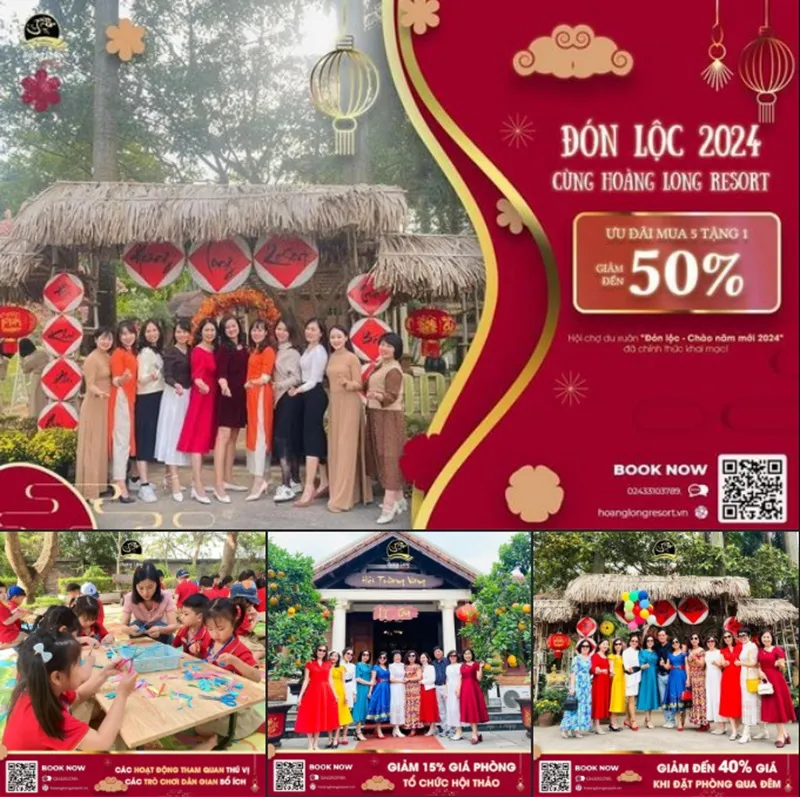
Important Notes When Traveling to Tay Phuong Pagoda
To make your trip to Tay Phuong Pagoda smooth and meaningful, you need to pay attention to the following:
- Dress code: Choose polite, discreet clothing, suitable for the solemn space of pagodas. Avoid wearing clothes that are too short, revealing, or too brightly colored.
- Footwear: You should choose comfortable shoes that are easy to move in because you will have to climb stairs and walk quite a lot during your pagoda visit.
- Luggage: Bring a hat, sunscreen, insect repellent, and drinking water, especially in the summer. If you prepare offerings, you should choose vegetarian offerings that are simple and suitable for Buddhist culture.
- Behavior: Maintain a respectful and solemn attitude when visiting the pagoda. Do not talk loudly, laugh, or make noise, causing disorder. Do not arbitrarily pick flowers, break branches, or infringe on the pagoda’s landscape.
- Environmental protection: Do not litter indiscriminately, maintain general hygiene within the pagoda grounds.
- Ask permission before filming or taking photos: If you want to film or take photos at the pagoda, you should ask permission from the Pagoda Management Board for guidance and compliance with regulations.
Conclusion
Traveling to Tay Phuong Pagoda is not only a journey to explore a historical and cultural relic, but also an opportunity to find a peaceful place, calm your mind in a sacred space, and admire unique artistic masterpieces. With its unique cultural, historical, and architectural values, Tay Phuong Pagoda deserves to be an attractive spiritual tourist destination that you should not miss when coming to Hanoi. Hopefully, the detailed information about traveling to Tay Phuong Pagoda shared by “Travel Around The World” will help you have a truly meaningful and fulfilling trip.